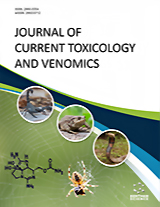Abstract
Background: Crotalus durissus cumanensis (C.d.c.) is the most widely distributed snake in Venezuela, causing the majority of snakebite envenoming.
Objective: The purpose of this study was to produce IgY antibodies against a C.d.c. venom pool from different Venezuelan regions and evaluate their neutralization capacity on various venom toxic activities.
Methods: Anti-C.d.c. venom antibodies are purified from chicken egg yolks by precipitation with polyethylene glycol and further analyzed by Multiple Antigen Blot Assay, indirect ELISA, Western blot, and Inhibition assays. In addition, we evaluate the phospholipase, edematogenic, and hemorrhagic activities. In addition, a new envenoming simulation study using anti-C.d.c. venom IgY in mice is presented.
Results: In this study, we show that anti-C.d.c. venom IgY is capable of neutralizing 4 LD50 doses of the Cdc venom (i.e., 1.76 mg of IgY neutralized 14 μg of C.d.c. venom) and effectively neutralizing the phospholipase, edematogenic and hemorrhagic activities. Additionally, the anti C.d.c. venom IgY specifically recognizes polypeptide bands with apparent molecular masses of ~ 54.55, 30.39, 24.1, 14.02, and 9.44 kDa by western blot. The IgY specificity is demonstrated by a dose-dependent inhibition, in which antibodies pre-adsorbed with the C.d.c. venom does not recognize the proteins contained in the venom. Furthermore, in the simulation study of envenoming, the mice inoculated with IgY showed no response.
Conclusion: Our results support the use of anti-venom IgY as an alternative to traditional equine therapy in animals and, eventually, in human patients bitten by C.d.c snakes.
[http://dx.doi.org/10.1016/j.ijid.2010.02.1789]
[PMID: 23947002]
[http://dx.doi.org/10.1016/j.toxicon.2007.03.012] [PMID: 17482229]
[http://dx.doi.org/10.1016/j.etp.2007.04.002] [PMID: 17616380]
[http://dx.doi.org/10.1016/S0041-0101(02)00393-8] [PMID: 12676433]
[PMID: 1366776]
[http://dx.doi.org/10.1016/S0165-022X(02)00002-7] [PMID: 12062112]
[http://dx.doi.org/10.1111/j.1365-2796.1994.tb01032.x] [PMID: 8283161]
[http://dx.doi.org/10.1016/j.toxicon.2009.11.004] [PMID: 19925817]
[http://dx.doi.org/10.1016/j.toxicon.2007.06.017] [PMID: 17681579]
[http://dx.doi.org/10.1136/vr.143.21.579] [PMID: 9854769]
[http://dx.doi.org/10.1128/AEM.02608-15] [PMID: 26475102]
[http://dx.doi.org/10.1186/s40409-016-0078-3] [PMID: 27563307]
[http://dx.doi.org/10.1186/s40409-017-0112-0] [PMID: 28396683]
[http://dx.doi.org/10.1016/j.xphs.2022.02.008] [PMID: 35196538]
[http://dx.doi.org/10.1016/j.toxicon.2013.01.018] [PMID: 23416799]
[http://dx.doi.org/10.1016/j.ejps.2017.05.069] [PMID: 28595875]
[http://dx.doi.org/10.1016/j.toxicon.2019.03.020] [PMID: 30914282]
[http://dx.doi.org/10.1007/BF01832882]
[http://dx.doi.org/10.1177/026119290503300208] [PMID: 16180988]
[http://dx.doi.org/10.1016/S1095-6433(01)00508-6] [PMID: 11867282]
[http://dx.doi.org/10.7705/biomedica.v20i4.1077]
[http://dx.doi.org/10.1096/fasebj.4.8.1970792]
[http://dx.doi.org/10.1089/10966200260398198] [PMID: 12495588]
[http://dx.doi.org/10.1016/S0065-3519(99)80036-6]
[http://dx.doi.org/10.1016/j.toxicon.2013.08.058] [PMID: 23994592]
[http://dx.doi.org/10.3109/08820138509022667] [PMID: 4065934]
[http://dx.doi.org/10.1038/227680a0] [PMID: 5432063]
[PMID: 4377238]
[http://dx.doi.org/10.1016/S0165-2478(98)00055-8] [PMID: 9719439]
[http://dx.doi.org/10.1016/j.exppara.2006.01.007] [PMID: 16513113]
[http://dx.doi.org/10.1016/0041-0101(85)90380-0] [PMID: 3913055]
[http://dx.doi.org/10.1016/0742-8413(86)90069-1] [PMID: 2877785]
[http://dx.doi.org/10.2144/01313dd05] [PMID: 11570510]
[http://dx.doi.org/10.1021/pr9009518] [PMID: 19911849]
[http://dx.doi.org/10.3390/toxins10100393] [PMID: 30261694]
[http://dx.doi.org/10.1016/j.actatropica.2021.106119] [PMID: 34481791]
[http://dx.doi.org/10.1021/pr9008749] [PMID: 19863078]
[http://dx.doi.org/10.3390/toxins14080532] [PMID: 36006194]
[http://dx.doi.org/10.3390/molecules25153401] [PMID: 32731325]
[http://dx.doi.org/10.3390/toxins8100304] [PMID: 27782073]
[http://dx.doi.org/10.19053/01217488.v11.n1.2020.9869]
[PMID: 15754746]
[http://dx.doi.org/10.1590/S0100-879X1997000100004] [PMID: 9222399]
[http://dx.doi.org/10.1016/j.toxicon.2004.03.011] [PMID: 15284014]
[http://dx.doi.org/10.1016/S0041-0101(99)00238-X] [PMID: 10758279]
[http://dx.doi.org/10.1016/0041-0101(76)90090-8] [PMID: 982480]
[http://dx.doi.org/10.1097/MBC.0b013e328304e02e] [PMID: 18685436]
[http://dx.doi.org/10.1016/0041-0101(74)90073-7] [PMID: 4376285]
[http://dx.doi.org/10.1016/j.toxicon.2015.01.006] [PMID: 25598498]
[http://dx.doi.org/10.1016/S0167-4838(01)00217-5] [PMID: 11451438]
[http://dx.doi.org/10.1002/(SICI)1522-7189(199802)6:1<15:AID-NT2>3.0.CO;2-S]
[http://dx.doi.org/10.1016/S0041-0101(01)00245-8] [PMID: 11821121]
[http://dx.doi.org/10.1016/j.toxicon.2008.04.179] [PMID: 18590753]
[http://dx.doi.org/10.1016/j.toxicon.2003.11.006] [PMID: 15019493]
[http://dx.doi.org/10.1371/journal.pntd.0000318] [PMID: 18923712]
[http://dx.doi.org/10.1016/j.intimp.2019.05.015] [PMID: 31128529]









